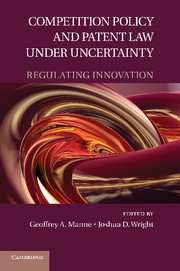Book contents
- Frontmatter
- Contents
- Contributors
- Introduction
- PART I THE INSTITUTIONS OF GROWTH
- PART II THE ECONOMICS OF INNOVATION
- PART III INNOVATION AND COMPETITION POLICY
- PART IV THE PATENT SYSTEM
- PART V PROPERTY RIGHTS AND THE THEORY OF PATENT LAW
- 12 Commercializing Property Rights in Inventions
- 13 The Modularity of Patent Law
- 14 Removing Property from Intellectual Property and (Intended?) Pernicious Impacts on Innovation and Competition
- PART VI INTELLECTUAL PROPRETY AND ANTITRUST: THE REGULATION OF STANDARD-SETTING ORGANIZATIONS
- Index
- References
13 - The Modularity of Patent Law
Published online by Cambridge University Press: 05 June 2012
- Frontmatter
- Contents
- Contributors
- Introduction
- PART I THE INSTITUTIONS OF GROWTH
- PART II THE ECONOMICS OF INNOVATION
- PART III INNOVATION AND COMPETITION POLICY
- PART IV THE PATENT SYSTEM
- PART V PROPERTY RIGHTS AND THE THEORY OF PATENT LAW
- 12 Commercializing Property Rights in Inventions
- 13 The Modularity of Patent Law
- 14 Removing Property from Intellectual Property and (Intended?) Pernicious Impacts on Innovation and Competition
- PART VI INTELLECTUAL PROPRETY AND ANTITRUST: THE REGULATION OF STANDARD-SETTING ORGANIZATIONS
- Index
- References
Summary
Introduction
At the core of controversies over the correct scope of intellectual property lie grave doubts about whether intellectual property is property. Property covers a broad range of resources, from solid objects like land and cars, to fugitive resources like water, to intangibles like debts. But, as a resource, information is different from all of these. From the consumer point of view, information is nonrival; one person's enjoyment of the plot of Hamlet does not diminish another's (if anything, the opposite), and preventing people from using information – excluding them – is difficult. Although information itself is a public good and, once known, would be consumed at zero marginal cost, discovering and making information useful requires inputs that are rival and are susceptible to efforts to exclude. Edison's labor in testing filaments for the light bulb (not to mention his lab equipment and working space) were as rival and excludible as shrimp salads or Blackacre (the classic examples). On various theories, patent rights are said to give incentives to invent, develop, and commercialize information such as the light bulb. Other intellectual property rights regimes, such as copyright, focus more on creation, and yet others, like trademark, are concerned more with commercialization rather than creation. Yet all of these regimes reflect a concern that in their absence people will have too little incentive to engage in one or more activities with respect to information – from discovering it, to commercializing it, to using it to lower consumer search costs.
- Type
- Chapter
- Information
- Competition Policy and Patent Law under UncertaintyRegulating Innovation, pp. 377 - 415Publisher: Cambridge University PressPrint publication year: 2011



